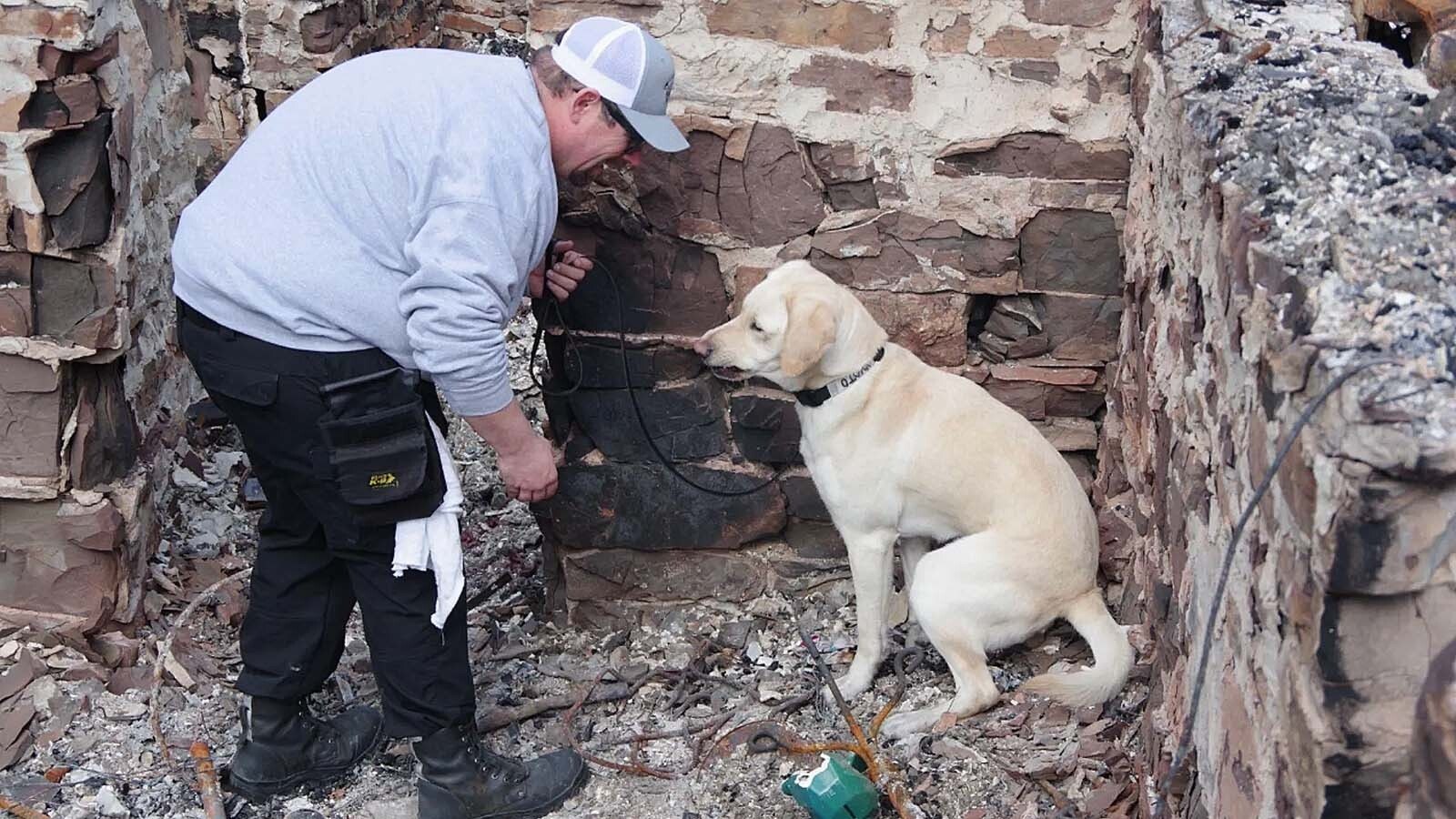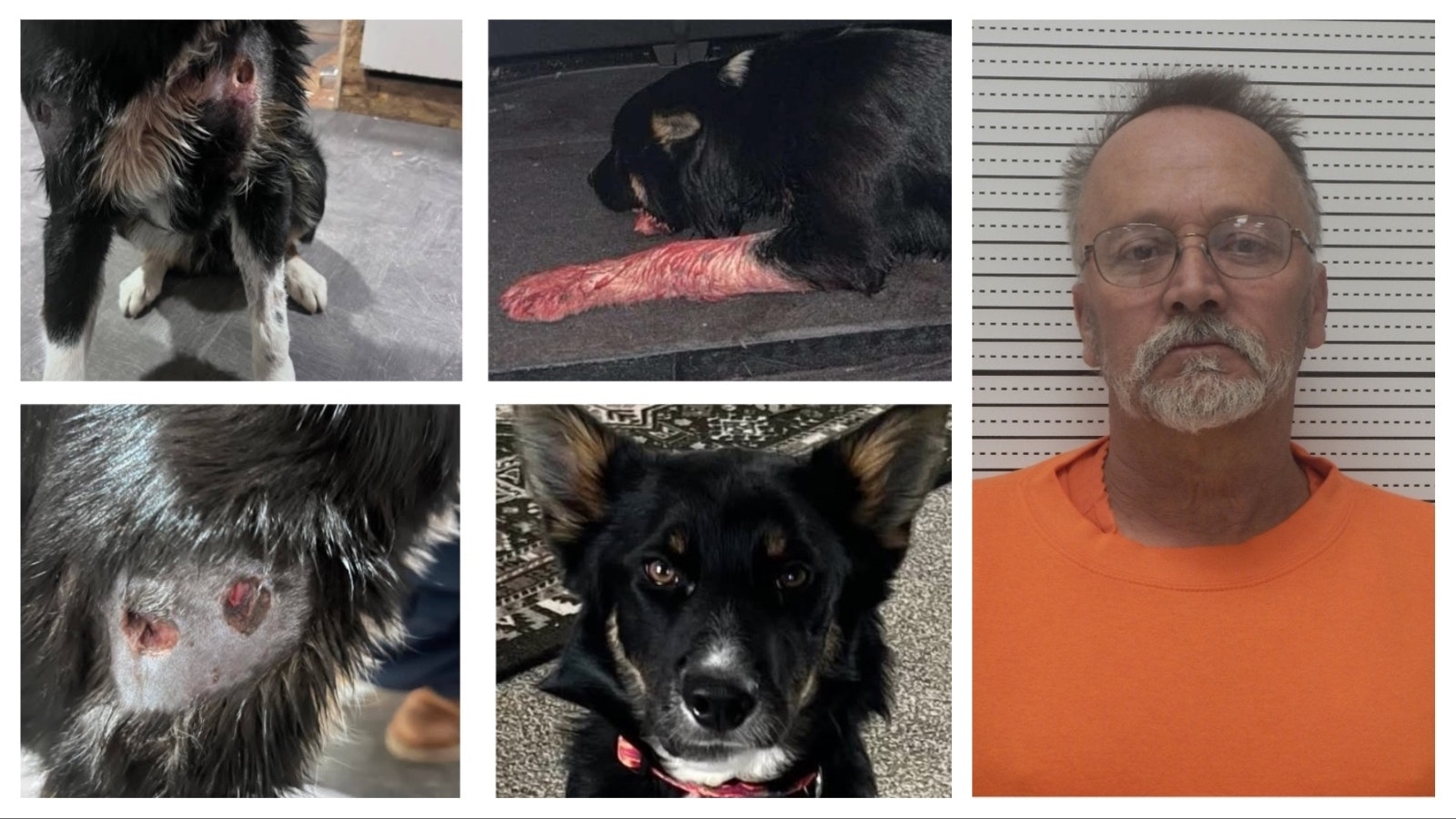RIVERTON — Kyoto is a dog with three distinct personalities.
On one hand, he’s like every other 3-year-old yellow Labrador retriever who likes to yank on chew toys and roll over on his back for belly rubs.
He also has no idea he’s too big to be a lapdog and takes advantage of anyone who sits down.
When he’s not playing like most dogs, he also likes a good nap.
The day Cowboy State Daily caught up with him, Kyoto lazed in the shade provided by handler Eric Siwik’s leg as he rested on the pavement by his feet outside the Wyoming State Fire Marshal’s training center in Riverton.
Where he differs from other dogs, however, is his day job sniffing out accelerants as Wyoming’s first arson-detecting dog.
This side of his personality was immediately apparent when Siwik strapped a black bag around his waist, which brought Kyoto to his feet and signified it was time to get to work.
It also signals mealtime, and it's the only time Kyoto gets to eat.
On the ground outside of the lightly singed house used for fire training, Siwik set up an obstacle course for the canine filled with various burned items — pieces of wood, cardboard and a stuffed animal among other things — some containing a small dropper’s worth of gasoline.
This is one of many petroleum distillates that Kyoto is trained to detect as he quickly made his way through the course, sniffing items until he sat down next to a piece of burned rug.
That's his way of indicating the accelerant.
Siwik then commanded Kyoto to point out the spot with the gasoline, which he deftly did with the tip of his nose.
This earned him a handful of dog food pulled from the bag, incentivizing Kyoto to sniff his way through the rest course, earning additional handfuls.
Less than a minute later, Kyoto again passed another test with a perfect score and a belly full of food.
Proving His Worth
Rarely, if ever, does Kyoto miss, and he's already proving himself to be a valuable asset as Wyoming’s first ATF-trained accelerant detection dog.
Kyoto has been with the agency for about 18 months with his partner Siwik, an investigator and trainer who was hand-picked to be his handler.
Since joining the small crew of seven statewide arson investigators, Kyoto went out on 21 calls in 2024 and nine so far this year. This is a fraction of the roughly 50 calls the agency has responded to this year alone.
Of those that Kyoto investigated this year, he detected accelerants at two fire scenes, which were later confirmed by the state lab.
One of those hits led to the arrest of a woman in Lovell suspected of attempting to set her ex-partner’s car and garage on fire.
Both Kyoto’s accuracy and speed are two of the assets that have earned him a valuable spot on the seven-member crew of state fire investigators, said Senior Investigator Chris McDonald, who could not help bragging up both his canine team and fellow investigators.
McDonald, who has been with the agency since March, said Kyoto is just one more asset that his crew can provide when it comes to helping fire departments detect the cause of fires and be a liaison between law enforcement in cases where arson may be a factor.
He and his team are available to agencies at their request to investigate fires, McDonald said, including structure and wildland fires.
McDonald said Kyoto has already saved valuable time when it comes to investigating what can be extremely complicated fire investigations.
Not only can he detect an accelerant, but his ability to locate the spot within 2 inches of where it was applied also helps determine what items to send to the crime lab for verification.
Becoming An ATF Dog
It’s an affordable tool for Wyoming, McDonald said, because the dogs are paid for by the ATF, which also provides preliminary and follow-up trainings.
The ATF began training accelerant detection canines (ADCs) in 1986, according to the agency. To date, there are about 70 trained canines around the nation.
Kyoto was born in 2022 and comes to Wyoming from Susquehanna Service Dogs in Pennsylvania.
The accelerant detection dogs start training as puppies and go through a rigorous selection based on the dog’s scent ability, work drive, and degree to which it’s motivated by food, Siwik said.
Not all pups are food-driven, which immediately weeds them out.
With the ability to detect thousands of different ignitable liquids, Siwik said these dogs are also trained to discriminate between other smells that may be present at the scene like burnt wood, plastic and smoke.
Dogs in general have superior scent ability and can smell more than 1,000 times better than humans, Siwik said.
He compared it to a human’s ability to smell a pot of stew as one smell, whereas a dog can parse out every single ingredient.
For his part, Kyoto has the smells down.
At his last re-certification test, he scored a 100%, which is typical of most of these well-trained dogs.
Along with being good sniffers, ATF accelerant dogs also have strict weight requirements depending on the dog’s size and respective frames.
For Kyoto, his target weight is 60 pounds. Three pounds in either direction can cause him to lose certification.
The initial training includes six weeks at the ATF Canine Training Center in Virginia, followed by additional training when dogs return with their handlers to their respective fire departments.
In exchange, the dogs become part of a national response team and can be called out at the federal agency’s request for emergencies in other states.
The working dogs also have a mandatory retirement age of 9, per ATF policy, which means Kyoto should have at least six more years on the job if he stays healthy.
Once retired, he’ll remain with Siwik.
Will Work For Food
The state agency, in turn, picks up the tab for food and training, which never ends. In fact, Kyoto literally works for food.
He’s food-driven meaning he only gets to eat while training. This is part of ATF’s “Food to Work” system designed to motivate the dogs to work hard.
This is one reason that the federal agency chose Labs as their primary breed of choice, because they are naturally food motivated.
What this means for Siwik and Kyoto is that the work never ends with the pair training up to three times a day, which amounts to about two cups of food for Kyoto, or 30 handfuls.
Even on his most tired days, Siwik has never cheated, he said, and Kyoto has never eaten out of a bowl.
In terms of training, Siwik keeps a shelf full of accelerants in his office for these purposes, from diesel fuel to fuel injector fluid.
So far, Kyoto has been able to easily identify accelerants on site. The only time he struggles is when there’s food at a fire scene, particularly dog food that can be distracting.
“He’s a dog, after all, and he can get easily sidetracked,” Siwik said.
Kyoto is just one tool in the toolbox for investigators.
Fire investigation is a science unto itself and relies on a complicated understanding of both fire behavior and reading burn patterns. Some are easy to detect, Siwik said, while others like completely burned down structures present a real challenge for investigators.
Siwik describes it as dissecting a room, starting with the point at which the fire may have begun and then studying the burn patterns and having a keen understanding of the ways fire spreads.
McDonald, who does not have an extensive fire background, has watched both Siwik and the other investigators work and describes the group as a top-notch team who continually blows him away at the meticulous way they can triage a fire scene and ascertain the cause.
Sometimes, Siwik said it’s easy when you walk into the structure and immediately smell an accelerant. Those cases are rare, however, he said, and it typically involves hours of investigation to decipher the origin and cause.
Not A Job
For Siwik, taking on Kyoto has been a lifestyle change, which he was told it would be when he accepted the role. He knew it was going to be a lot of work with the constant training on top of being available to travel wherever needed without a moment’s notice for fire investigations.
Luckily, for Siwik, it doesn’t feel like a job.
He's wanted to be a fireman as long as he can remember. After high school, he studied fire science at Montana State University and joined the Wyoming State Fire Marshals in 2011. He also serves as volunteer fire chief for the Lander Volunteer Fire Department.
Taking on the role as Kyoto’s handler, allows him to learn a different facet of investigation, he said, namely learning to work as a team with the canine.
The hardest part for Siwik was learning to read Kyoto’s signs. Some dogs will snort, chatter their teeth or wag their tails, but Kyoto sits down when he smells an accelerant and also starts breathing heavier.
Siwik also had to learn to control his own movements, too, when on scene investigation because Kyoto follows his lead, sitting if Siwik stops to look at something or getting confused about what he’s supposed to be doing.
As far as McDonald is concerned, Siwik and Kyoto make a perfect match. And though he had nothing to do with Siwik’s being selected as handler, he said he, too, would have put the two together given Siwik’s calm, easy-going demeanor and his meticulousness to details.
“Eric and Kyoto are really well matched,” McDonald said. “Both stay calm and focused on scene and that works well with upset individuals because they have a calming presence.”
Proud Dad
Siwik has many “proud dad” moments that he rattled off, including the time that Kyoto expertly navigated across missing floorboards in a badly burned kitchen fire in Jackson.
“I was so proud he was able to get across those boards without any hesitation,” he said.
He also appreciates Kyoto’s sweet nature and the way he interacts with witnesses at the scene, some of whom have just lost their entire worlds. Not only is he friendly, but he also helps put people at ease, Siwik said, much like a therapy animal.
He’s continually impressed with Kyoto’s work ethic and abilities on the job.
Most notably, he recalled the summer of 2024, when he and Kyoto were tasked to investigate a string of wildland fire-related calls. In one day, he and Kyoto worked six separate fire scenes on a sweltering day.
“He performed exceptionally well in the heat of the day,” Siwik said. “I feel like this highlights not only his capabilities, but the stamina to keep working when you could tell he was tired.”
No doubt there will be more proud moments to come in what is just the beginning of his career in Wyoming.
Jen Kocher can be reached at jen@cowboystatedaily.com.












